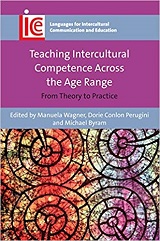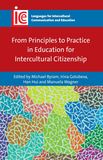Wagner, M., Conlan Perugini, D., & Byram, M. (2017). Teaching intercultural competence across the age range.Bristol, England: Multilingual Matters.
Byram, M., Golubeva, I., Hui, H., Wagner, M. (2016). From principles to practice in education for intercultural citizenship. Bristol, England: Multilingual Matters.
 Much of the literature that discusses the implementation of teaching for intercultural competence in second language (L2) contexts has been prescriptive rather than descriptive. According to Byram and Feng (2004), the literature focuses more on what ought to be done regarding the teaching of culture in L2 classrooms rather than what is actually taking place. TESOL professionals interested in developing their students’ intercultural competence could look to a number of publications that offer well-illustrated strategies for teaching intercultural competence, including the classic (though no longer “new”), New Ways in Teaching Culture(Fantini, 1997), as well as Intercultural Language Teaching Activities (Corbett, 2010) and Tips for Teaching Culture (Wintergerst & McVeigh, 2011). These three publications draw from the authors’ and contributors’ own experiences, but they do not offer empirical research. In addition to field-tested strategies, TESOL professionals also need empirical research examining the challenges, outcomes, and potential benefits associated the use of such strategies in varied contexts. The case studies included in two new volumes address this gap in the literature. Much of the literature that discusses the implementation of teaching for intercultural competence in second language (L2) contexts has been prescriptive rather than descriptive. According to Byram and Feng (2004), the literature focuses more on what ought to be done regarding the teaching of culture in L2 classrooms rather than what is actually taking place. TESOL professionals interested in developing their students’ intercultural competence could look to a number of publications that offer well-illustrated strategies for teaching intercultural competence, including the classic (though no longer “new”), New Ways in Teaching Culture(Fantini, 1997), as well as Intercultural Language Teaching Activities (Corbett, 2010) and Tips for Teaching Culture (Wintergerst & McVeigh, 2011). These three publications draw from the authors’ and contributors’ own experiences, but they do not offer empirical research. In addition to field-tested strategies, TESOL professionals also need empirical research examining the challenges, outcomes, and potential benefits associated the use of such strategies in varied contexts. The case studies included in two new volumes address this gap in the literature.
 The first publication, Teaching Intercultural Competence Across the Age Range, edited by Manuela Wagner, Dorie Conlan Perugini, and Michael Byram, reports on how a group of motivated educators set out to systematically implement teaching for intercultural competence in their L2 classrooms. The eight chapters are arranged by grade level and discuss the techniques, challenges, and opportunities associated with integrating a focus on intercultural competence within L2 classes. At the elementary level, Patty Silvey and Silke Gräfnitz describe a fourth-grade project examining international housing practices, Dorie Conlon Perugini shares about a fourth-grade inquiry unit examining modes of transport in Puerto Rico, and Philip Rohrer and Lauren Kagan discuss how fifth graders used the five senses to deconstruct their understanding of cities in the United States while also exploring Mexico City. At the secondary level, Jean Despoteris and Komo Ananda share how eighth graders came to adopt a new perspective on daily chores by comparing their daily routines with those of youth in rural Peru, Deanne Wallace and Jocelyn Tamborello-Noble show how tenth and eleventh graders gained a new perspective on the immigrant experience through volunteering with Spanish-speaking communities, and Chelsea Connery and Sarah Lindstrom discuss a project for eleventh and twelfth graders focused on differing global perspectives on beauty. At the university level, Manuela Wagner and Niko Tracksdorf share their experiences and challenges teaching and assessing intercultural competence in an online beginning German language and culture course. The volume concludes with a chapter by Lauren Rommel and Michael Byram, which offers a synthesis of research about how teachers can develop intercultural competence through study and experience abroad. The first publication, Teaching Intercultural Competence Across the Age Range, edited by Manuela Wagner, Dorie Conlan Perugini, and Michael Byram, reports on how a group of motivated educators set out to systematically implement teaching for intercultural competence in their L2 classrooms. The eight chapters are arranged by grade level and discuss the techniques, challenges, and opportunities associated with integrating a focus on intercultural competence within L2 classes. At the elementary level, Patty Silvey and Silke Gräfnitz describe a fourth-grade project examining international housing practices, Dorie Conlon Perugini shares about a fourth-grade inquiry unit examining modes of transport in Puerto Rico, and Philip Rohrer and Lauren Kagan discuss how fifth graders used the five senses to deconstruct their understanding of cities in the United States while also exploring Mexico City. At the secondary level, Jean Despoteris and Komo Ananda share how eighth graders came to adopt a new perspective on daily chores by comparing their daily routines with those of youth in rural Peru, Deanne Wallace and Jocelyn Tamborello-Noble show how tenth and eleventh graders gained a new perspective on the immigrant experience through volunteering with Spanish-speaking communities, and Chelsea Connery and Sarah Lindstrom discuss a project for eleventh and twelfth graders focused on differing global perspectives on beauty. At the university level, Manuela Wagner and Niko Tracksdorf share their experiences and challenges teaching and assessing intercultural competence in an online beginning German language and culture course. The volume concludes with a chapter by Lauren Rommel and Michael Byram, which offers a synthesis of research about how teachers can develop intercultural competence through study and experience abroad.
 The second book, From Principles to Practice in Education for Intercultural Citizenship, edited by Michael Byram, Irina Golubeva, Han Hui, and Manuela Wagner, addresses the possibility of integrating citizenship education with a focus on intercultural competence in L2 classrooms. It is divided into three sections, the first of which concerns undergraduate students’ baseline perceptions of intercultural and global citizenship in a number of different contexts: Irina Golubeva, Manuela Wagner, and Mary E. Yakimowski discuss the perspectives of students in Hungary and the United States; Han Hui, Song Li, Jing Hongtao, and Zhao Yuqin discuss the perspectives of two groups of students in China; and Ulla Lundgren, in collaboration with her students, discusses the perspectives of students in Sweden. Across the three chapters, findings reveal that more systematic intercultural citizenship holds great potential, but that curriculum designers must respect local sociopolitical factors, particularly in locations like China, where such factors are particularly sensitive. The second section addresses teacher collaboration: Etsuko Yamada and Jessie Hsieh tell about the use of student action research on social issues in a Japanese as a second language class in Japan and an English class in Taiwan, and Stephanie Ann Houghten and Mei Lan Huang discuss the implementation of environmentally focused community service projects within university EFL classes in Japan and Taiwan. Both chapters reveal great opportunities associated with cross-context partnerships. The third section of the book addresses internet-mediated learner cooperation and includes helpful information regarding challenges and opportunities for teachers wishing to replicate the projects described. Melina Porto, Petra Daryai-Hansen, María Emilia Arcuri, and Kira Schifler describe how young EFL learners in Argentina and Denmark planned and discussed environment-oriented community service projects together. Catherine Peck and Manuela Wagner identify opportunities for intercultural learning within a lesson-planning collaboration between preservice teachers in the United States and South Korea. Melina Porto describes a project in university EFL classes in Argentina and Italy that asked students to observe and analyze mural art and graffiti and that led each group to action within their communities. Melina Porto and Leticia Yulita contribute two chapters discussing conversation exchanges about sensitive topics between students in the United Kingdom and Argentina; in the first, students discuss the Malvinas/Falklands war, and in the second, they discuss the broader issue of human rights. The volume concludes with reflections by the editors about the potential for learning, challenges, and next steps. The second book, From Principles to Practice in Education for Intercultural Citizenship, edited by Michael Byram, Irina Golubeva, Han Hui, and Manuela Wagner, addresses the possibility of integrating citizenship education with a focus on intercultural competence in L2 classrooms. It is divided into three sections, the first of which concerns undergraduate students’ baseline perceptions of intercultural and global citizenship in a number of different contexts: Irina Golubeva, Manuela Wagner, and Mary E. Yakimowski discuss the perspectives of students in Hungary and the United States; Han Hui, Song Li, Jing Hongtao, and Zhao Yuqin discuss the perspectives of two groups of students in China; and Ulla Lundgren, in collaboration with her students, discusses the perspectives of students in Sweden. Across the three chapters, findings reveal that more systematic intercultural citizenship holds great potential, but that curriculum designers must respect local sociopolitical factors, particularly in locations like China, where such factors are particularly sensitive. The second section addresses teacher collaboration: Etsuko Yamada and Jessie Hsieh tell about the use of student action research on social issues in a Japanese as a second language class in Japan and an English class in Taiwan, and Stephanie Ann Houghten and Mei Lan Huang discuss the implementation of environmentally focused community service projects within university EFL classes in Japan and Taiwan. Both chapters reveal great opportunities associated with cross-context partnerships. The third section of the book addresses internet-mediated learner cooperation and includes helpful information regarding challenges and opportunities for teachers wishing to replicate the projects described. Melina Porto, Petra Daryai-Hansen, María Emilia Arcuri, and Kira Schifler describe how young EFL learners in Argentina and Denmark planned and discussed environment-oriented community service projects together. Catherine Peck and Manuela Wagner identify opportunities for intercultural learning within a lesson-planning collaboration between preservice teachers in the United States and South Korea. Melina Porto describes a project in university EFL classes in Argentina and Italy that asked students to observe and analyze mural art and graffiti and that led each group to action within their communities. Melina Porto and Leticia Yulita contribute two chapters discussing conversation exchanges about sensitive topics between students in the United Kingdom and Argentina; in the first, students discuss the Malvinas/Falklands war, and in the second, they discuss the broader issue of human rights. The volume concludes with reflections by the editors about the potential for learning, challenges, and next steps.
The studies in these two volumes show that teachers in diverse settings can integrate meaningful intercultural content within their L2 classrooms, provided they have sufficient preparation, support, and motivation. The variety of settings in which these case studies take place offers evidence that teaching culture for intercultural competence and citizenship is a possibility in many contexts. These case studies offer helpful descriptions of promising practices that could be used to build students’ interculturality. ICIS members would likely enjoy both volumes, which are clearly written, accessible, and practically-focused. Those interested in implementing intercultural language teaching for young learners or adolescents should start with Wagner, Conlan Perugini and Byram’s Teaching Intercultural Competence Across the Age Range, which contains more case studies in primary and secondary settings. Those interested in learning more about the potential to encourage intercultural citizenship through language teaching, would likely find Byram, Golubeva, Hui & Wagner’s From Principles to Practice in Education for Intercultural Citizenship more helpful.
Most of the case studies in these two volumes could be described as action research. The chapter authors describe the practices they used in their own classrooms, and draw on evidence from their experiences (e.g., student work, interviews, or journal entries) to discuss the impact of the practices described. Their efforts to share evidence-based accounts of their own teaching practices are to be applauded. Future research studies could build on the case studies shared in these two volumes by replicating their methods in other settings or by tracking the long-term impact of the teaching practices on the students and communities involved. One major weakness of these two volumes is that the majority of the case studies take place within the classrooms of highly motivated teachers in well-resourced settings. More research is needed to examine the use of practices that effectively build students’ interculturality in lower resourced settings, where teachers might not have as much support and preparation. Nevertheless, these two volumes are a meaningful contribution to the field. They offer clear models of effective and creative intercultural teaching practices, and they discuss the challenges, opportunities, and outcomes, associated with the use of those practices. In these two volumes, TESOL and L2 educators can find models to build upon as they enact intercultural language teaching with their own students.
References
Byram, M., & Feng, A. (2004). Culture and language learning: Teaching, research and scholarship. Language Teaching, 37(3), 149–168.
Corbett, J. (2010). Intercultural language activities. Cambridge, England: Cambridge University Press.
Fantini, A. E. (Ed.). (1997). New ways in teaching culture. Alexandria, VA: TESOL International Association.
Wintergerst, A. C., & McVeigh, J. (2011). Tips for teaching culture: Practical approaches to intercultural communication. White Plains, NY: Pearson.
Tabitha Kidwell is a doctoral candidate in applied linguistics and language education at the University of Maryland, College Park. She has taught languages and trained teachers on five continents. Her research interests focus on language teacher education, particularly how language teachers are prepared to teach about culture. |

